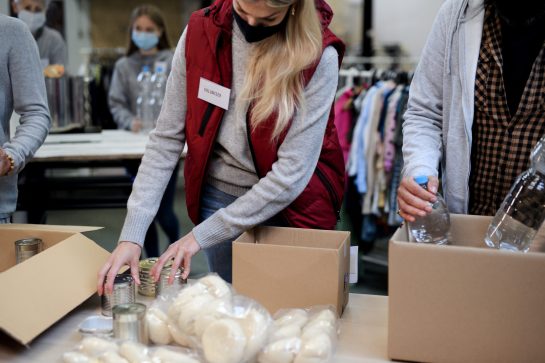Hunger in the United States is rising, and food and nutrition services are looking to the Supplemental Nutrition Assistance Program (SNAP) for help. As the new administration is challenging lawmakers to increase the financial support for SNAP, food programs are hoping to see an increase in both benefits and eligibility.
GROWING HUNGER IN THE US
As the COVID-19 pandemic continues to surge, one of the nation’s most urgent issues, food insecurity, is growing.
Feeding America estimates that over 50 million Americans experienced hunger in 2020, up more than 15 million from 2019. This growth is also disproportionately affecting children and minorities. While 1 in 7 households in the US are currently experiencing hunger, this number jumps to 1 in 5 for Black and Latino homes (1).
With hunger and unemployment rising to record highs, food programs are scrambling to meet the need.
THE PRESENT STATE OF FOOD BANKS
Food Bank for the Heartland is a program experiencing the unprecedented strain. Serving 93 counties in Nebraska and Iowa, their monthly cost went from $80,000 pre-pandemic to over $1.5 million. This increase reflects the exponentially growing number of people in need of basic nutrition.
These programs are not just in need of more food to distribute.
The majority of food bank volunteers are in the most vulnerable age bracket for COVID-19 (2). With risk of contraction still high, many programs have seen a decrease in helping hands. While food banks are usually short on workers—along with resources like transportation and storage capacity—the pandemic has only increased such gaps.
THE POWER OF FOOD
Despite the difficulties, the work these food programs are doing could not be more critical.
Food security continues to be one of the leading social determinants of health. An individual’s ability to access good nutrition is strongly correlated with important health outcomes including, diabetes, depression, and general health (3).
For children, food security can have an even longer impact. Food secure children do better in school, suffer from less mental health challenges, and are less likely to be underweight (4). A child’s ability to enjoy the carefree play of their youth is severely stunted by hunger, and the consequences are long-lasting.

Over 50 million Americans experienced food insecurity in 2020. Prior to the
coronavirus pandemic, food insecurity was on a steady twelve-year decline.
HELP ON THE HORIZON?
As food insecurity grows, both individuals and food programs are looking to one initiative in particular: The Supplemental Nutrition Assistance Program, or SNAP. Previously known as Food Stamps, SNAP is the leading governmental assistance program for those experiencing food insecurity.
Individuals who are enrolled in SNAP are 30% less likely to be food insecure than those who are eligible, but do not apply. It is incredibly effective at developing food security, and experts estimate that for every single meal provided by a food bank, SNAP can provide nine (5).
When food programs and SNAP work together, their impact can grow exponentially. However, with limited resources and funding for SNAP, non-profit organizations may be shouldering more of the burden.
CHALLENGES SURROUNDING SNAP
In December 2020, the federal government increased funding for SNAP so all recipients would receive the maximum amount of support (6). While helpful to many, this did not increase resources for those already receiving the full amount—or in other words, those most vulnerable and in need.
Additionally, some people report being unable to register for SNAP. While Food Bank for the Heartland originally had advertisements on their website offering to help people sign up for SNAP, they eventually had to take them down (7).
“We would get such a huge call volume that with our limited staff, we just had no ability to keep up,” explained Food Bank for the Heartland’s CEO Brian Barks.
It seems clear that the best way to help increase food security will be to expand SNAP.
CHANGES FOR SNAP MAY BE ON THE WAY
Just last month, the new administration challenged Congress to update funding for SNAP (8). They will begin by addressing the Thrifty Food Plan, which establishes the baseline for how much money SNAP users receive. This plan was last updated in 2006 and relies on assuming individuals have time and energy to make all their food from scratch, like soaking beans overnight instead of using canned beans. Some people worry this might not be a realistic standard for families working two or three jobs.
More than anything, advocates are pushing for two big changes to SNAP:
- Increase in benefits for those receiving SNAP.
- Increase in eligibility so more individuals and families can qualify.
Experts argue that even a $160 increase in the monthly maximum could reduce food insecurity for SNAP users by up to 60%. With expansion of SNAP eligibility, these benefits could have far-reaching effects.
While SNAP could hold the answers for much of the nation’s food insecurity, it is going to take time. Meanwhile, food and nutrition programs will continue to do their best to assist in efforts to dullthe growing hunger across the states. Data and case management is increasingly important for such organizations to maximize efforts, and software like ClientTrack™ can help food and nutrition programs do exactly that. ClientTrack™ has data collection and reporting standards compliant with USDA and USAID and can include programs like SNAP.
And right now, the need for food and nutrition has never been higher.



